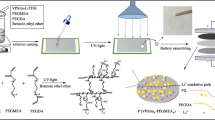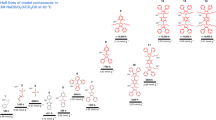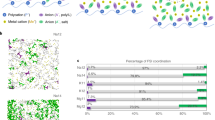Conclusions
In this paper, we describe a prospective approach to increasing the metal ionic conductivity of solid polymer electrolytes by using the anion complexation between the anion of the metal salt and the solvent matrix. We have prepared a new type of solid polymer electrolyte (CP/LiCl/ PVC) and demonstrated its excellent ionic conductivity. The high ionic conductivity of this material is attributed to anion complexation between the anions and their receptors (CPs) dissolved in the PVC matrix. The anion complexation of CP, which should help to increase both the concentration of free Li+ and its mobility, is more favorable with Cl− than ClO4 −. Consequently, such systems have high cation conductivity and characteristics of high performance electrolytes that are required to achieve high power density and good rechargeability for lithium batteries.
Similar content being viewed by others
References
For example, F. M. Gray, inPolymer Electrolytes, J. A. Connor, Ed., the Royal Society of Chemistry, 1997.
Y. Yoon, J. Won, and Y. S. Kang,Macromolecules,33, 3185 (2000).
S. U. Hong, J. H. Jin, J. Won, and Y. S. Kang,Adv. Mater.,12, 968 (2000).
H.D. Cho, J. Won, H. Y. Ha, and Y. S. Kang,Macromol. Res.,14, 214 (2006).
D. E. Fenton, J. M. Parker, and D. V. Wright,Polymer,14, 589 (1973).
For example, a) M. Armand, W. Gorecki, and R. Andreanis, inProc. Second International Symposium on polymer electrolytes, B. Scrosati, Ed., Elsevier, London, 1990, p. 91.
H. S. Lee, X. Q. Yang, J. McBreen, Z. S. Xu, T. A. Skotheim, and Y. Okamoto,J. Electrochem. Soc.,141, 886 (1994).
J. McBreen, H. S. Lee, X. Q. Yang, and X. Sun,J. Power Source,89, 163 (2000).
X. Sun, H. S. Lee, X. Q. Yang, and J. McBreen,J. Electrochem. Soc.,149, A335 (2002).
X. Sun, H. S. Lee, X. Q. Yang, and J. McBreen,J. Electrochem. Soc.,149, A1450 (2002).
H. S. Lee, Z. F. Ma, X. Q. Yang, X. Sun, and J. McBreen,J. Electrochem. Soc.,151, A1429 (2004).
M. C. Lanregan, M. A. Ratner, and D. Shriver,J. Am. Chem. Soc.,117, 2344 (1995).
P.A. Gale, J. L. Sessler, V. Král, and V. J. Lynch,J. Am. Chem. Soc.,118, 5140 (1996).
V. Král, P. A. Gale, P. Jr. Anzenbacher, K. Jursikova, V. Lynch, and J. L. Sessler,J. Chem. Soc. Chem. Commun.,9, (1998).
V. Král, J. L. Sessler, T.V. Shishkanova, P. A. Gale, and R. Volf,J. Am. Chem. Soc.,121, 8771 (1999).
J. B. Foresman, T. A. Keith, K. B. Wiberg, J. Snoonian, and M. J. Frisch,J. Phys. Chem.,100, 16098 (1996).
H. S. Lee, Z. Yang, J. McBreen, L. S. Choi, and Y. Okamoto,J. Electrochem. Soc.,143, 382 (1996).
Author information
Authors and Affiliations
Corresponding author
Rights and permissions
About this article
Cite this article
Won, J., Lee, K.M., Kang, Y.S. et al. Anion complexation by calix[4]pyrrole in solid polymer electrolytes. Macromol. Res. 14, 404–407 (2006). https://doi.org/10.1007/BF03219102
Received:
Revised:
Issue Date:
DOI: https://doi.org/10.1007/BF03219102




